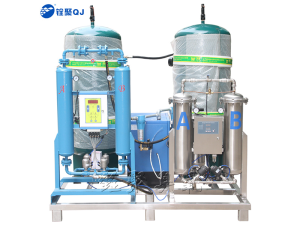Industrial oxygen generators are widely used in different occupations, and metallurgy is one of them. Today, Xinqing Gas mainly introduces the use of VPSA oxygen generators in the metallurgical field. What are the main effects of industrial oxygen generators?
Let's take a gold refinery as an example to look at the detailed use of industrial oxygen generators. Oxygen is consumed in the process of gold alchemy. At this time, if we use a VPSA oxygen generator to blow high-purity oxygen, the oxygen will oxidize with carbon, phosphorus, sulfur, and silicon. This not only reduces the carbon content of steel, but also helps eliminate impurities such as phosphorus, sulfur, and silicon. Moreover, the heat generated during the oxidation process is sufficient to maintain the temperature required for the steelmaking process. Therefore, oxygen blowing not only shortens the exercise time, but also improves the quality of steel. Therefore, we can say without exaggeration that the industrial oxygen generator plays a very important effect in the field of metallurgy. After long-term verification, it was discovered that the oxygen steelmaking method is top-blown converter steelmaking, which has the advantages of high speed, high output, multiple varieties, good quality and low investment. Therefore, we have seen that many VPSA oxygen generators are commonly used for oxygen blowing exercises such as smoke blowing converters, open furnaces and electric furnaces.
Work flow of industrial oxygen generator:
After the air is compressed by the air compressor, the cubic oxygen generator enters the air storage tank after dust removal, oil removal, and drying, and enters the left adsorption tower through the air intake valve and the left intake valve. The pressure of the cubic oxygen generator increases. The nitrogen molecules in the compressed air of the cubic oxygen generator are adsorbed by the zeolite molecular sieve, and the unadsorbed oxygen passes through the adsorption bed, and enters the oxygen storage tank through the left gas production valve and oxygen gas production valve. This process is called left suction, and the duration is Dozens of seconds. After the left suction process is completed, the left adsorption tower and the right adsorption tower are connected through a pressure equalizing valve to make the pressure of the two towers reach equilibrium. This process is called pressure equalization, and the duration is 3 to 5 seconds. After the pressure equalization is completed, the compressed air enters the right adsorption tower through the air intake valve and the right intake valve. The nitrogen molecules in the compressed air of the cubic oxygen generator are adsorbed by the zeolite molecular sieve, and the enriched oxygen passes through the right gas production valve and oxygen gas production. The valve enters the oxygen storage tank. This process is called right suction and lasts for tens of seconds. At one time, the oxygen adsorbed by the zeolite molecular sieve in the left adsorption tower was released back into the atmosphere through the left exhaust valve, and this process is called desorption. On the contrary, when the left tower is adsorbed, the right tower is also desorbed. In order to completely discharge the nitrogen released from the molecular sieve to the atmosphere, the oxygen passes through a normally open back-purge valve to purge the desorption adsorption tower, blowing the oxygen in the tower out of the adsorption tower. This process is called backflushing, and it is carried out together with desorption. After the right suction is completed, it enters the pressure equalization process, and then switches to the left suction process, and the cycle continues.


